
MARS FOREST LIFE BIO-
DIVERSITY-5: Part
1
Report 114
January 29, 2007
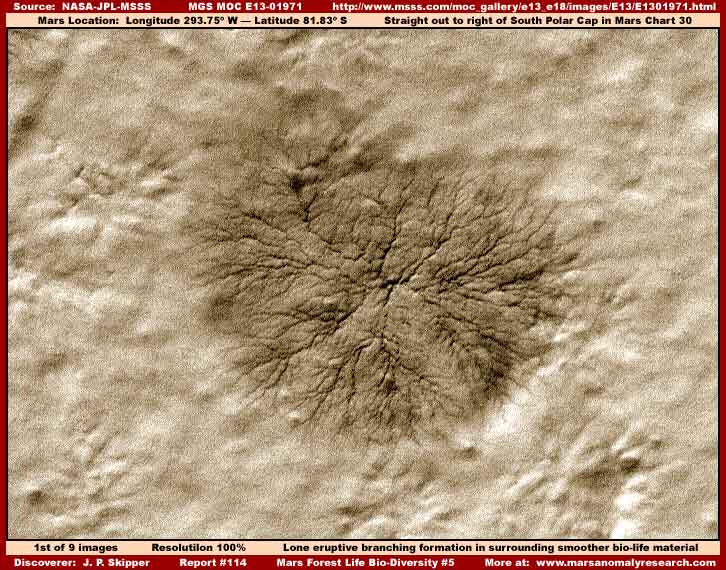
This report moves us more into the stranger looking and harder to visually identify Mars forest life evidence. By perception it is most often assumed to be natural geology rather than life. That may be understandable if one views each image strip as an island having little to do with other strip evidence. However, when one looks at many different still images encompassing a region of terrain and correlates all of the accumulative evidence in one's head, a truer understanding of the bio-life and its presence begins to emerge.
Now that does not mean that I will be successful here in conveying to most viewers in just a few images in this short reporting style my own experience with a great many images and the understanding that comes with that but I will try the best I can. I'm a cautious measured fellow not given to flights of fantasy and yes I'm satisfied that in the end posterity will eventually confirm what I say here in this report and prove me right or you can bet I wouldn't be willing to stick my neck out on this so far on this particular limb. So be prepared to meet the strange and unfamiliar here.
I call this evidence forest life for the lack of a better term because it covers vast geological surface terrain areas just like tree forests do here on Earth. But, make no mistake about it, this evidence is most definitely not trees nor could even a single tree or much of anything else for that matter survive where this choking colony life evidence proliferates. Rather the evidence in this report is some kind of colossal size mold, fungi, algae, lichen or combination thereof type of life form unique to Mars that occupies a great deal of territory on the planet in its many different evolved forms that heavily influences Mars' land as well as surface water conditions. You should also know that the site of this bio-life evidence in this report is located in the South Polar Region terrain not too far out from the Cap.
Fortunately for us, sometimes this type of evidence can be fairly well seen in the MGS MOC imaging without too much image tampering obscuring it other than basic resolution treatments. This is probably because those that would hide truth probably thought no one here on Earth would ever be able to identify this colossal size evidence as being distinct from the natural geology it sort of some times resembles if one stretches one's imagination quite a bit. Also, this type of evidence changes appearance and in some of its transformation cycles it looks just a little too similar to natural geology making it very difficult in the programming stage for the tampering software to distinguish it and its different changing looks from true natural geology as you will hopefully begin to understand here in this reporting.
The above first and below second images are taken from the MGS MOC E13-01971 narrow-angle strip. Yes the most obvious feature of course is the lone slightly darker color large single branching formation in the center of the image. However, the much smoother light color more reflective material surrounding it on all sides is important to and you are cautioned to start with not to assume that this is some kind of smooth terrain. The fact is that everything you see above is the same bio-life evidence and there is no natural geology visible at all.
Yes, if such evidence is viewed alone, it is very easy to come to the tentative initial conclusion that this is some strange eruptive branching geological thing happening in the surrounding natural smooth even if fuzzy looking geological terrain, but that isn't the case here. This unfamiliarity to the eye difficulty of identification and the human tendency to try to force unfamiliar looking evidence into a category more familiar regardless of whether it fits or not is why this kind of evidence is initially dismissed as geology, even if strange, and doesn't get as much image tampering treatment as does so much other evidence more familiar to the Earth human eye and easier to accurately interpret.
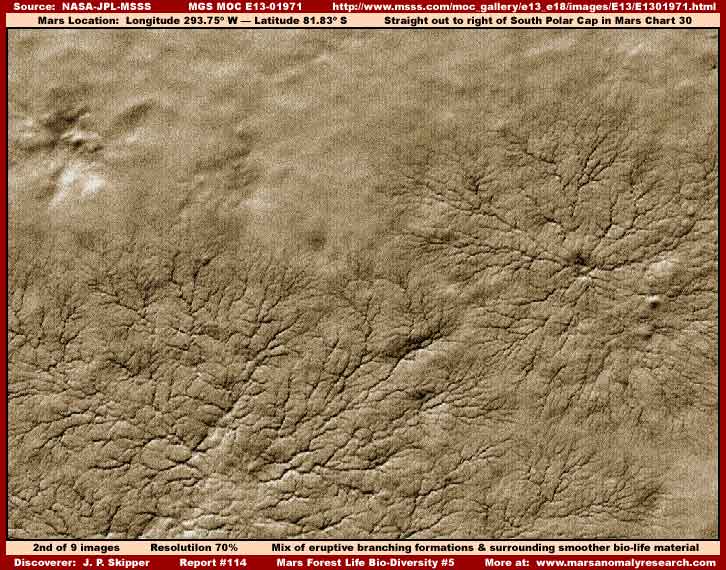
The above second image is from the same E13-01971 strip as the first image but further down in the strip and demonstrates the same evidence. However, here you will note that the branching formations are clustering and mixing together. This is actually the edge of a large area of such branching clusters bordering on a large area of the smoother material. Although it may look like a closer view of the evidence because the branching clusters are larger here, this view is actually more distant at 30% less than in the first image and encompasses the entire width of the original strip from one side to the other.
Again note the smooth material in the top area of this second image but note that it is slightly darker and less reflective here than the smooth material in the first image. This apparent to the eye color slight darkening shift of the smooth stage is typical of this evidence as it moves from the smooth look toward this darker branching eruptive stage look. Again I want to be sure that you understand that every bit of what we are seeing here in these images is the same bio-life evidence, just going through different stages of its life cycle with dramatic changes in its look, and no natural geology is visible here at all, only life bio-mass material covering the land.
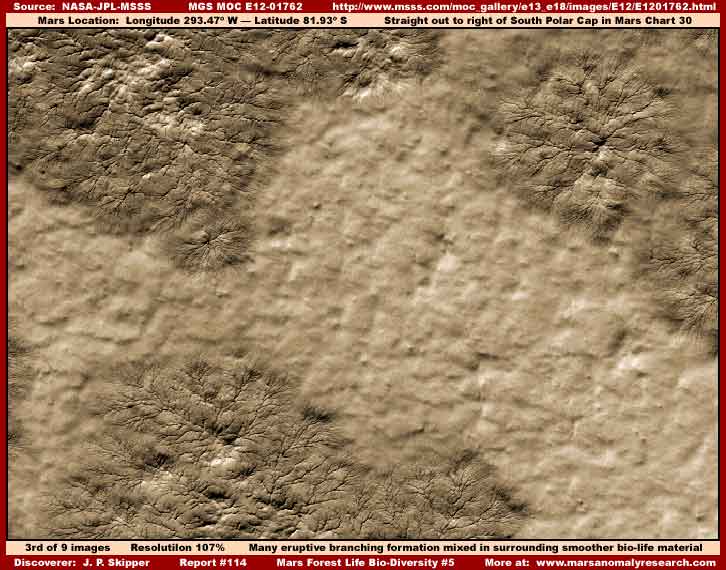
The above third image as well as the next two images below are the same evidence in the same general locale as the first two images above. This evidence is again located not too far out in the terrain from the South Polar Cap but from a different E12-01762 strip and represents a view encompassing from one side of the original strip to the other. Once again you see the same branching from a central point formations clustering together and bordered here by the smoother ever so slightly darker less reflective and here slightly lumpier material.
However, in this third image evidence note the lumpy knobby disposition of the evidence in the very center depressions of the clusters, especially those on the bottom left and upper left. The reason that I'm drawing your attention to this much more subtle evidence within the center of the branching formations is because this the beginning stage of another very different transformation look this bio-life form exhibits as will become increasingly clearer in the images of its further development below.
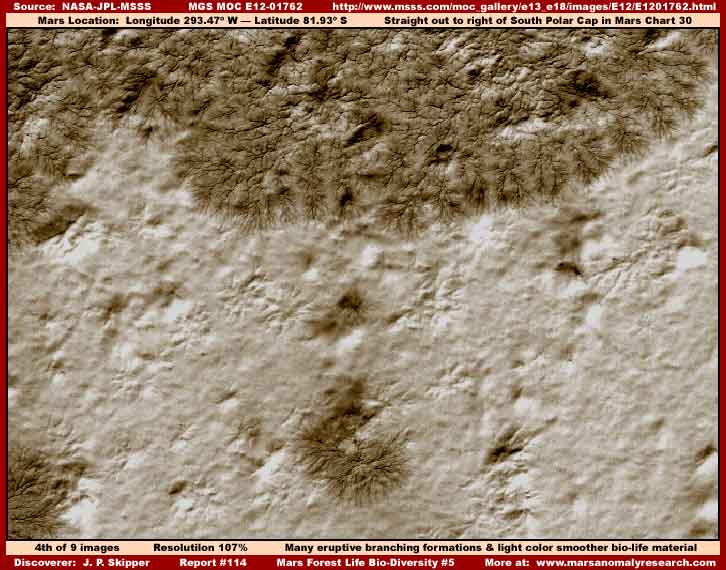
The above fourth image is from the same E12-01762 strip as the third image and again encompasses one side boundary of the original strip to the other. This image is taken from a point down the strip just a bit from that of the third image. Note again the more pronounced rough lumpy knobby texture surface back in the interior areas of the branching clusters well back away from the outer edges.
Note too the lighter color much more light reflective smoother bio-life surface areas in the mid and lower areas of the image. Now note that there are vestigial remaining imprints of branching forms in this smoother material indicating that the branching form areas are no longer active and are probably being reabsorbed as the smoother areas continue to smooth over in these places.
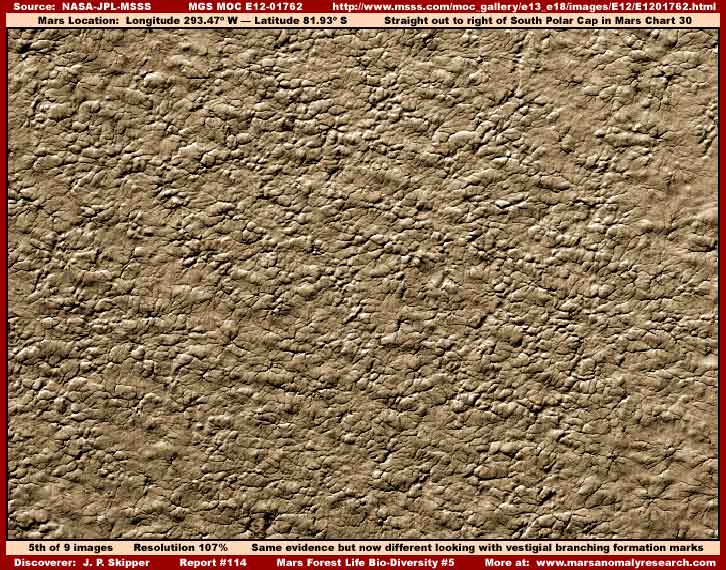
The above fifth image evidence is again from the same E12-01762 strip but now from a point down near the bottom of the strip. As you can see, this surface looks dramatically different than either the combination of branching formation clusters or the smoother texture areas. Unfortunately, the transition from the more eruptive branching evidence to this more lumpy knobby look is quite gradual and not sharp and with a total of six images I'm running out of image room in this Part-1 for those on a dial-up connection, so I couldn't adequately capture the transition look in imaging this small and didn't want to take up file space in this Part-1 with much larger imaging or more images.
Yet, this is all the same evidence no matter that the above now looks a little more like geology. In fact, after two strips and six images here in Part-1, we have still not seen even the slightest sign of actual natural geology! If you will look very closely in the above fifth image, you can still see what evidence is left of many smaller vestigial branching formations all in this scene. Before you leave this reporting, I urge you to visit the E12-01762 science data .GIF straight orientation strip at the link below and scroll back and forth up and down the strip. This will better demonstrate to you the transition from one evidence transformation look to another and help you to better understand that everything seen in the strip is the same but changing life bio-mass.
I suspect that soon this fifth imaged area of the bio-mass will settle back down to a smoother if still slightly lumpy surface texture as well as a increasingly lighter color similar to the smoother areas in the above third and fourth images. After that, I suspect the surface texture will continue to settle down to an even smoother relatively featureless unbroken surface texture until the next cycle starts initiated with the warning darker color shift and the beginnings of the branching formations.
The bottom line is that I suspect what we are looking at here is a representative sample of a very long established very successful immense, even if inadequately identified (by us), bio-mass many many miles across. I suspect it is a form of colony life thriving on relatively low flat long existing ground water thoroughly saturated plains fed by seasonal flooding from the nearby South Polar Cap and, as some of you know, I have already reported on such Polar seasonal flooding cycles in my Report #077 titled "Mars South Pole Flood Waters." I suspect we are looking at some massive hybrid algae/fungi/mold cooperative or perhaps even an ancient evolved form of sea life that doesn't just engulf these low level plains but adheres to them and their shallow surface water resources like glue choking out and leaving room for nothing else that might compete with it.
I suspect that the more dormant of the appearance cycles is this particular bio-mass specie at its smoothest surface texture state and that the branching forms beginning to form in this smoother material are a form of gigantic propagation bloom created within it extending up to and erupting through the upper surface where it branches out from a central depression point in the bio-mass. As the branching form's bloom eruption expands larger and larger the basic bio-mass within its circumference is heaved up by the underlying eruption into increasingly rougher and more coarse appearing very lumpy knobby surface material. When the bloom upheaval stage is spent, the lumpy knobby surface remains for a time but gradually diminishes by sinking back down into the basic underlying bio-mass returning to a smoother and smoother more calm surface state.
In other words, the all encompassing living bio-mass can transform itself into three basic appearances. One is the smoother more dormant more light reflective state that can be mistaken for very poorly seen smoother fuzzy geology appearance. The second is the very active eruptive branching spreading formations state that is the strangest and most inexplicable of all. It just doesn't fit anything known from a geological point of view making it the sticking point. The third is the residual rough lumpy knobby state that once again can be mistaken for lumpy knobby geological terrain. Of course, each state also exists in varying degrees of changing transition appearance.
These different transformation looks happen at different times and in different areas of the immense bio-mass, so a single strip can include all three looks in it with two out of the three tending to resemble geology. That is the case with E12-01762 strip that served up the above third, fourth and fifth evidence images and it is the case with the S08-01258 strip that will be the source of the images in Part-2 of this report. This increases the tendency to try to force the interpretation of this evidence into geology rather than life because of its unfamiliarity. The only stumbling point in that interpretation is the branching formations that fit no geology identification. It's actually very simple, it doesn't fit because it isn't geology.
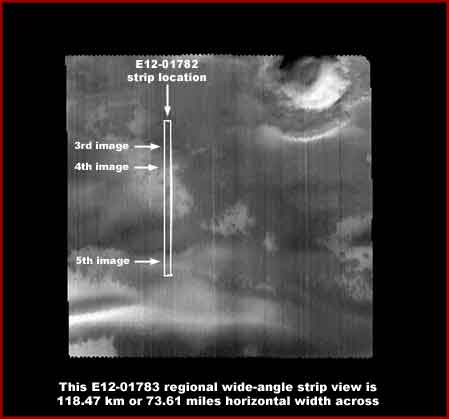
The above smaller sixth image is the whole companion E12-01783 wide-angle regional size scale strip rotated to a straight up and down orientation over the original. Be aware that it has no image clarity improvements in by me, only my text and labels have been added. The long slender white outline in it is the location of the E12-01782 narrow-angle strip from which my third, fourth and fifth image evidence above was drawn. Note that the location of those three imaged sites within the E12-01782 strip are pointed out with the arrows. Note too that this companion reference strip scene measures 118.47 km or 73.61 miles across from one side edge of the strip to the other according to the official statistics. I've included this wide-angle regional reference image here to give you an idea of what is really going on with this bio-life evidence in this wider terrain context.
The great bulk of the light and dark tones you see in this image is almost certainly entirely this bio-mass in different stages of transformation rather than the natural geology of rocks and soil. Based on the evidence in the E12-01782 strip, it is logical to reason that the darker tones represent the branching bloom eruptive formation activity while the lighter reflectivity tones represents the same bio-mass in various smoother calmer states. As you can see, this bio-mass does not represent some kind of isolated small patch but is really extensive life evidence on a colossal scale. Although I'm not showing it here, I can tell you that other wide-angle images confirm this evidence extends far beyond the boundaries of the image swath width you see above and you begin to understand what I meant when I said previously in a bit of a understatement that this evidence is many many miles across and is very active and successful.
Now that you've been initially exposed to this type of strange bio-life evidence in the above Part-1 and its six images, let's take that increasing familiarity and move on to the Part-2 imaging providing an even better look at this type of evidence.
DOCUMENTATION
http://www.msss.com/moc_gallery/e13_e18/images/E13/E1301971.html: This link accesses the official E13-01971 science data strip that is the source of my first and second images in this report Part-1.
http://www.msss.com/moc_gallery/e07_e12/images/E12/E1201762.html: This link accesses the official E12-01762 science data strip that is the source of my third, fourth, fifth, and sixth images in this report Part-1.
http://www.msss.com/moc_gallery/e07_e12/images/E12/E1201763.html: This link accesses the official E12-01763 science data strip that is the source of my measurement data associated with the sixth image in this report Part-1.
, Investigator
![]()